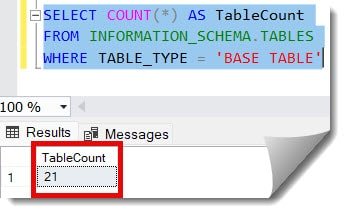As a senior SQL developer, I often get the requirement to determine the number of tables in an SQL server database. I analyzed and identified a few approaches to help you achieve this task. I will walk you through all those approaches individually with examples and best practices in this article.
Approach-1: Using sys.tables
The simple approach is to use the sys.tables for this purpose. We can execute the query below.
SELECT COUNT(*) AS TableCount
FROM sys.tables
WHERE type = 'U'After executing the above query, I got the expected output below.

Check out How To View Table In SQL Server Management Studio
Approach-2: Using INFORMATION_SCHEMA
We can also use the INFORMATION_SCHEMA for this purpose. We can use the below query for this purpose.
SELECT COUNT(*) AS TableCount
FROM INFORMATION_SCHEMA.TABLES
WHERE TABLE_TYPE = 'BASE TABLE'After executing the above query, I got the expected output, as shown in the screenshot below.

Check out How To Copy Table Schema In SQL Server
Approach-3: Using sys.databases
If you wish to get the table count from all the databases using the query below,
DECLARE @mysql NVARCHAR(MAX) = '';
SELECT @mysql = @mysql + 'SELECT ''' + name + ''' AS DatabaseName, (SELECT COUNT(*) FROM [' + name + '].sys.tables) AS TableCount UNION ALL '
FROM sys.databases
WHERE database_id > 4 AND state = 0;
SET @mysql = LEFT(@mysql, LEN(@mysql) - 10);
EXEC sp_executesql @mysql;After executing the above query, I got the expected output below.

Check out How to Get Table Row Count in SQL Server
Approach-4: Using specific table schema
We can also get the total number of tables based on a specific schema. To do so, we can execute the below query, where the table schema name is dbo.
SELECT COUNT(*) AS TableCount
FROM sys.tables t
JOIN sys.schemas s ON t.schema_id = s.schema_id
WHERE s.name = 'dbo'After executing the above query, I got the expected output below.

Conclusion
Understanding how to get the total table count in an SQL Server is essential for a developer or DBA working in an SQL server. You can either use sys.tables, INFORMATION_SCHEMA, sys.databases, etc. Now, it’s your decision to check which approach best suits you.
You may also like following the articles below.
- How To Save Query Results As Table In SQL Server
- How to Alter Table Column to Allow NULL in SQL Server
- How to Find Table Dependencies in SQL Server

Grey is a highly experienced and certified database expert with over 15 years of hands-on experience in designing, implementing, and managing complex database systems. Currently employed at WEX, USA, Grey has established a reputation as a go-to resource for all things related to database management, particularly in Microsoft SQL Server and Oracle environments. He is a Certified Microsoft SQL Server Professional (MCSE: Data Management and Analytics) and Oracle Certified Professional (OCP), with Extensive database performance tuning and optimization knowledge and a proven track record in designing and implementing high-availability database solutions.